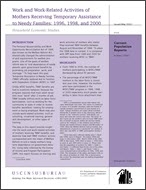Work and Work-Related Activities of Mothers Receiving Temporary Assistance to Needy Families: 1996, 1998, and 2000
Work and Work-Related Activities of Mothers Receiving Temporary Assistance to Needy Families: 1996, 1998, and 2000
Introduction
The Personal Responsibility and Work Opportunity Reconciliation Act of 1996, also known as the Welfare Reform Act, dramatically changed the administration of and requirements for welfare programs. One of the goals of welfare reform was to “end dependence of needy parents upon government benefits by promoting job preparation, work, and marriage.”1 To help reach this goal, Temporary Assistance to Needy Families (TANF) officially replaced Aid to Families with Dependent Children (AFDC) in 1997.
Unlike AFDC benefits, TANF benefits are tied to economic behavior, because the program requires that most adult recipients must “work” after 2 months of aid. TANF broadly defines work as labor force participation, such as working for the community or state in order to receive benefits (workfare), looking for employment or being employed. Work may also include work-related activities, such as schooling, vocational training, general skill development, or other types of training.
The data in this report provide insight into the work and work-related activities of mothers receiving TANF benefits, and examine how well TANF mothers’ actions corresponded with the intent of Welfare Reform to end a needy mother’s long-term dependence on government benefits. Using data collected by the Survey of Income and Program Participation (SIPP), this report focuses on training and work activities of mothers who stated they received TANF benefits between August and November of 1998.2 To place the 1998 data in context, it is compared with SIPP data from 1996 and 2000 for mothers receiving AFDC or TANF.3
_______________
1 Green Book 2000.
2 SIPP is a longitudinal survey that follows the same individuals over time. The survey is conducted in waves of 4 months’ duration, with one-fourth of sample members interviewed in each month of a wave. Sample members are asked about activities during the 4 months prior to the interview, which is known as the “reference period.” Individuals can leave and enter the survey over time. The focus of this report are the mothers who received TANF benefits on behalf of anyone within the nuclear family, such as the children, or the children and mothers during any month between August and November of 1998, when the Welfare Reform topical module was administered. A person is considered “on” welfare if there was any AFDC or TANF participation during a wave.
3 These data were collected during wave 1 (April -July 1996), wave 8 (August - December 1998) and wave 12 (December 1999 - March 2000) of the 1996 SIPP. In this report, 1996 refers to wave 1, 1998 refers to wave 8, and 2000 refers to wave 12. Please note that the population of mothers for Table 1, Table 2, and Figure 1 is different than for the rest of the tables and figures. Table 1, Table 2, and Figure 1 take a cross-sectional look at all mothers in 1996, 1998, and 2000. The remainder of the tables and figures refer to the cohort of mothers in 1998. This is discussed in the section “An important note on making longitudinal comparisons.”
Others in Series
Publication
Publication
Publication






